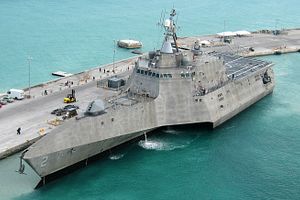The U.S. Navy christened its newest Independence-class Littoral Combat Ship (LCS), the future USS Cincinnati, during a ceremony in Mobile, Alabama on May 7, the service said in a statement.
The Cincinnati is the 11th ship built by Austal USA as part of the LCS program. LCS are divided into two classes, the Independence and Freedom variants. Construction of the latter variant is spearheaded by Lockheed Martin, while the former is led by Austal USA.
Independence-class LCS like the future USS Cincinnati feature a unique trimaran hull and a larger flight deck, allowing ships of this particular variant to carry two rather than one SH-60 Seahawk helicopter (or one Ch-53 Sea Stallion helicopter), next to multiple unmanned aerial vehicles. Additionally, the Independence-class also has a larger fuel capacity and a wider operational range. Freedom-class LCS have a monohull design with an aluminum superstructure.
Twenty-nine LCS contracts have been awarded to date. As I explained earlier this month:
Using an open architecture design, both LCS classes are modular, reconfigurable warships that can be fitted with interchangeable mission packages providing specific capabilities for surface warfare (SUW), anti-submarine warfare (ASW), and mine countermeasures (MCM) missions in the littoral region.
The armament of the future USS Cincinnati will likely consist of a 11-cell Raytheon RIM-116B SeaRAM missile-defense system, one 57-millimeter naval gun, AGM-114 L Hellfire missiles and Mark 5o torpedoes, and depending on the mission package, two Mk44 Bushmaster II 30-millimeter chain guns.
As I repeatedly pointed out, neither LCS variant was designed for high-intensity combat at sea, a major disadvantage for the U.S. Navy amid Chinese and Russian naval expansion. As a January 2018 report by the Pentagon’s office of Operational Test and Evaluation notes:
Survivability testing and preliminary analyses on both LCS variants continue to demonstrate that neither LCS variant is survivable in high intensity combat. Although the ships incorporate capabilities to reduce their susceptibility to attack, testing of analogous capabilities in other ship classes demonstrated that such capabilities have limited effectiveness in high intensity combat.
Indeed, the Pentagon’s operational testing and evaluation arm concluded in a study that a single hit could put an LCS out of action:
As designed, the LCS lacks redundancy and the vertical and longitudinal separation of vital equipment found in other combatants. These features are required to reduce the likelihood that a single hit will result in loss of propulsion, combat capability, and the ability to control damage and restore system operation.
Earlier this month, the Navy accepted delivery of the Independence-class LCS Tulsa, the 13th littoral combat ship to be delivered to the Navy and the eighth of the Independence variant to join the fleet. The future USS Tulsa is expected to be commissioned in San Francisco in late 2018.

































